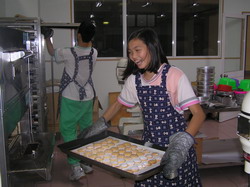Promoting crafts and skills education, cultivating multiple intelligences

Minister Tu Cheng-sheng of the MOE has repeatedly emphasized that children's futures should not to be judged by their academic accomplishments alone. Instead, we should spend more time finding out children's aptitudes. Minister Tu indicates that in order to cultivate children's multiple intelligences, enforce the spirit of equal educational opportunity and teaching students in accordance with their aptitude, the MOE in 1983 began promoting the Program to Implement the Extension of National Education with a Focus on Vocational Education. In 1993, it began promoting crafts and skills education classes in junior high schools, providing students with an alternative educational option.
After crafts and skills education classes completed their mission, in order to keep up with social changes, Minister Tu said beginning in the 2004 school year, junior high school crafts and skills education should return to the mainstream education system with an emphasis on career development education; hence the switch to a crafts and skills education curriculum. In the 2005 school year, the practical skills classes of senior vocational schools have been renamed practical skills curriculum, turning crafts and skills education into a new starting point in the hope of breakthroughs and innovations.
Minister Tu points out that contemporary Western educators advocate the concept of multiple intelligences, hoping to construct an individual knowledge system through students' individual discovery and learning. Therefore, the purpose of implementing the skill education curriculum is to respect students' individual differences and provide them with a curriculum that suits their individual abilities, aptitude, and interests in order to build their self-confidence in learning. The spirit conforms to the individualized teaching programs that pay attention to students' individual differences and developments.
Minister Tu said that, in terms of junior high schools, there were 1,043 skills education classes in the 2003 school year with 25,310 students enrolled. In the 2005 school year, there were 1,295 classes with 31,591 students enrolled. Students enrolled were those who were interested in the classes and participated voluntarily, which broadened the base of participants and fully demonstrated the vocational functions of skills education.
Meanwhile, in terms of senior vocational schools, Minister Tu said that after full-scale implementation in the 2005 school year, there were 400 classes with 15,000 students enrolled. The curriculum is designed to be employment-oriented in order to allow students of lower academic tendency obtain adequate development and help students gain practical abilities to enter the job market. In the past, after graduation, students could only obtain a certificate. Now students studying a practical skills curriculum can obtain a diploma from a vocational school, allowing students learn professional skills, rediscover the fun of learning, and build their self-confidence.